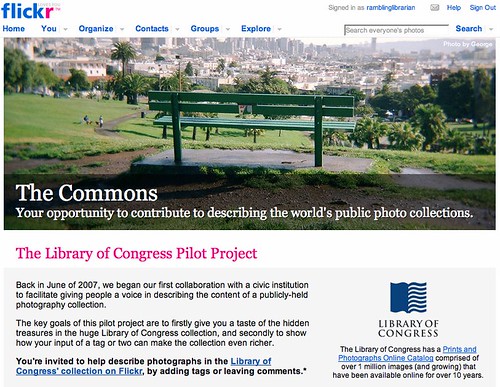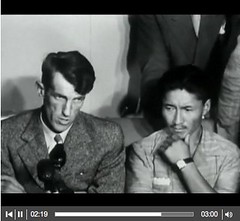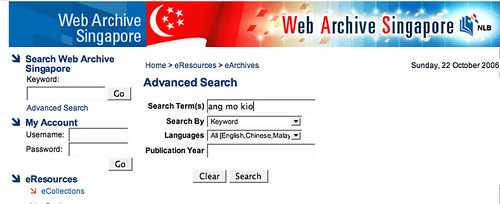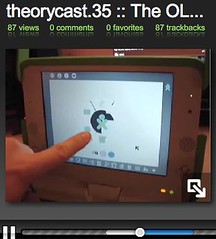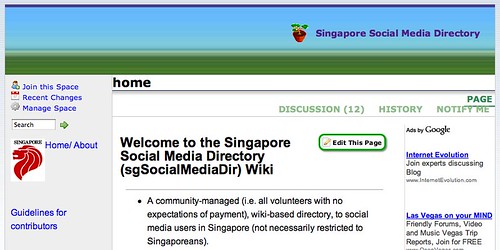 I agreed.
I agreed.Might as well provide an update on this Social Experiment from its start nine months ago.
Cherian suggested a progress report of sorts, on how it's evolved since then.
I'll do just that by sharing 10 observations on how the experiment went, and also share some thoughts on where this experiment will go.
ABOUT THE DIRECTORY/ WIKI
For the full details of the Whys and Hows about the directory, read this post.
I wanted to see how Singaporeans would react to a community-managed Wiki. I called it a "social experiment" because anyone could edit the wiki. If we allowed anonymous edits, how likely would it be vandalised? And would the community contribute to it?
The directory/ wiki was created on 20 March 2007. As far as I know, it was the first of its kind and remains the only one today -- if you're talking about a community-managed Wiki focusing on Singapore and Singaporeans.
STATISTICS on USAGE & ENTRIES (for 2007)
There are about 80 entries for Individuals and 60 Group entries (or 140 entries total) so far. I estimate about 85% to 90% of the entries were by me, with the rest contributed by others.
- Avg. Daily Page Views = 28 (or 7,900 page views total; most no. of views for a given day was 93)
- Avg. Daily Unique Visitors = 34 (or 9,750 unique visitors total; most no. of unique visitors for a given day was 107)
- Top 3 visits by countries = USA (46%), Singapore (42%), China (8%)

OBSERVATION #1 - No vandalism
None at all, in the nine months (after 7,900 page views and 9,750 unique visits).
And no one listed any spam entry or a link to an advertising site either. I also didn't get any complaints or requests for me to remove any entries.
Of course one could argue that the directory isn't that well used. The probability of vandalism increases with an increase in usage. Perhaps the directory isn't seen as important enough (like Wikipedia for instance), but I feel that's besides the point. There was no vandalism, period.
My view is that if we let the experiment continue long enough, vandalism and abuse is a really a matter of WHEN and not IF. But if there's pattern or threshold, I can't tell from this experiment.
I think the risk of vandalism tends to be overstated.
OBSERVATION #2 - Tendency to only include entries that "belonged to me", rather than those belonging to others
This was the second major observation. It was clear very early on that apart from myself, no one else added entries that belonged to others.
I made a point to check every link created by others. Of the estimated 10% to 15% of the entries were contributed by other people, all of them listed entries where they had direct association.
As Kevin once observed: "... from a motivational perspective... most people only added their blogs, rather than to contribute what they’ve found out on the web."
Some guesses why this was so:
- The communuity-contribution mindset isn't there yet. The prevalent attitude seems to be one of "I want others to find me" rather than "I think others should find this".
- Mindset of "I do not have their permission" and hence playing-it-safe by not doing anything. Perhaps there were concerns of intruding into other people's privacy.
OBSERVATION #3 - Not everyone wants to list themselves in the directory
I'd expected people to voluntarily list their blogs in the directory. However, that didn't seem to be the case.
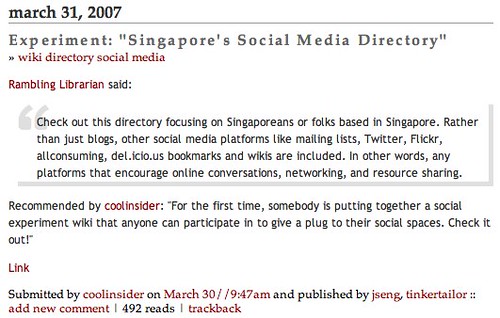 The directory was plugged at Tomorrow.sg on 31 March 2007 (thanks to Walter), which led to a spike in the directory's page views and unique visits. However, the number of contributions didn't increase proportionately.
The directory was plugged at Tomorrow.sg on 31 March 2007 (thanks to Walter), which led to a spike in the directory's page views and unique visits. However, the number of contributions didn't increase proportionately.The Tomorrow.sg entry registered about 490 reads when I took the screenshot today. That might be a major contributor to the visits to the directory, but it didn't automatically translate to the number of contributions.
Possible reasons why the 4,095 unique visitors -- from Singapore -- did not result in a corresponding proportion of entries:
- Not all visitors use new media services, so they have nothing of their own to add
- If they have, they might not see any value in being listed
- Their motivation for blogging (or using social media services) might not be to get widely noticed. So it doesn't really make a difference whether people find their blogs or not.
- Some may choose not to have people find their blog or site.
- Tendency is for people to "take", rather than "contribute" (submitting something to the directory did not occur to them)
- They are not sure how to contribute to the wiki
OBSERVATION #4 - Few "mistakes" made by contributors
 Of those who contributed, all of them managed to adhere to the specified format. I've had to do very little editing of other people's entries.
Of those who contributed, all of them managed to adhere to the specified format. I've had to do very little editing of other people's entries.Most users did it the "smart" way by copying and pasting an earlier entry, and then amending parts of it. I think the trick was to provide an example, and people would be able to follow the required format.
OBSERVATION #5 - Volunteers do step up to help
One user, who was a stranger to me, took the initiative to alphabetise the entries in response to a discussion on how to arrange the entries (see user "ModernBurrow", 31 Mar 2007 entry at this page).
His gesture surprised me, pleasantly. I didn't expect anyone to voluntarily help out. However, I think the directory has dropped off his radar screen, as there have not been further updates from him/ her. It was a positive outcome, nonetheless.
OBSERVATION #6 - Lack of widespread interest and awareness
I didn't have any expectations about usage. Compared to some of my personal blogs, the directory's usage is quite good.
But what the experiment seems to suggest so far:
- Few Singaporeans are interested in getting themselves listed. Some might do so after I tell them about it but there are relatively more who don't
- I get better responses when I invite people to list their entries, compared to sending out general calls via mailing lists
- Poor word-of-mouth by Singaporean bloggers. I searched for "Singapore Social Media Directory" in Google blog search and retrieved 13 links, of which about seven are by Singaporeans
OBSERVATION #7 - Profile of those who list themselves in the directory
I click through every entry created by others. Judging from the links to their entries, none of those entries belong to teenagers (i.e. 13 to 19). I get the impression most owners are in their mid-20s to mid-30s, from tertiary students to working professionals.
My guess is that teens don't really want to let the whole wide world know about their blogs. This impression is reinforced when I ask some teens who have blogs. They confirm that they mainly share their blogs with friends rather than deliberately let the world know that that they have a blog.
I suspect this is also true for adults who blogs.
OBSERVATION #8 - Spin-offs
About a month after the Singapore Social Media Directory was created, one Singaporean blogger (Clapping Tree) created a Asia Social Media Directory at AsiaSocialMediaDir.wikispaces.com. I commented in her post that it was a good initiative.
Out of curiosity, I looked at that wiki's 2007 statistics today. By my calculations, the Asia Social Media Dir wiki has:
- 22 Page Views Per Day on Average (comparable to the 28 for SgSocialMediaDir)
- 22 Unique Visitors Per Day on Average P(Vs. 34 for SgSocialMediaDir)
- Country of origin: 63% USA, 18% Singapore, 15% China (Vs. SgSocialMediaDir's 46% USA, 42% Singapore, 8% China)
I'd assumed that with its wider geographical coverage (Asia Vs Singapore), the contributions and access to the Asia directory would higher. But it doesn't seem to be the case (unless my calculations were wrong).
Perhaps being "Findable" is a factor (it helped that the Singapore directory was plugged by Tomorrow.sg). Also, although Asia has a wider geographical coverage than Singapore, the number of English-language blogs (and hence people who can read the directory) may not proportionately higher.
OBSERVATION #9 - Usefulness of the directory
Without any survey (formal or otherwise), this part is really my conjecture. Personally, I found the listings by Organisations more useful that individuals. Mainly because I've a greater need to look for institutional blogs than individuals.
OBSERVATION #10 - Keywords & Search is more critical than Categories
I deliberately avoided using subjects or categories for the directory. The only categories are alphabetical listings by "Individuals" and "Groups". The thinking behind this can be found here.
From using the directory, I found that that having meaningful keywords and having a reliable search feature is better than specifying fixed subject categories.
 As I understand from his book Everything Is Miscellaneous, David Weinberger suggests that the way to go with digital information is not impose any artificial constraints or limits on how entries were categorised. Because in doing so, we inevitably limit the scope of how items could be searched.
As I understand from his book Everything Is Miscellaneous, David Weinberger suggests that the way to go with digital information is not impose any artificial constraints or limits on how entries were categorised. Because in doing so, we inevitably limit the scope of how items could be searched.I find this to be true.
Even though I have created most of the entries, most times I rely on search feature to look for entries, especially for entries by individuals. I think the format (Title, Description, Keyword) is working out.
Of course the search isn't that precise, i.e. it lists the page which the entry appears but clicking through, you have to scroll (or do a FIND) to locate the exact entry. Still, it beats having to browse through each entry or page (or category, had we used it to organise the items).
However, that's not to say a directory-listing is useless. I think humans cannot yet move away from physical-world constraints. We're too used to having things compartmentalised. We expect things to be compartmentalised, if only for our psychological benefit.
I think having some categories (in this case, by Individuals and Groups) gives people an idea of what is IN the directory. But the real usefulness comes from the search feature.
If I were to build a Wiki, I'd pay attention to the search and indexing feature, and provide an easy way for users to tag keywords to entries.
FINAL REMARKS - Personal learning experience & future directions
After a year, I can say with greater certainty that the risk of a wiki being vandalised is not as great as one would think.
I'm glad I started the directory because from learning how it works and how people respond (or not respond) to it, I've gone on to help my NLB colleagues setup a Collaborative-Story Wiki for the Singapore Library Week (I was able to tell the developers specifically what features were needed, and discuss with my colleagues the likelihood of success and managing possible risks).
I've also created a wiki for my work with the IFLA Libraries for Children and Young Adults (see YA-guidelines.wikispaces.com)
Future directions
The Singapore Social Media Directory will continue to be available (so long Wikispaces continue to provide it as a free service).
It will still continue to be an experiment. I don't think the learning will end. I'll continue to update it, although I hope to see more community-participation. Perhaps after this update, more Singaporeans will learn about this and give ideas and feedback, if not actually contributing entries.
It is of some use to some people, I'm sure. If nothing else, I do use it from time to time.
Oh, I certainly DO NOT want this to be seen as "Ivan Chew's directory". I'd like to see myself as the catalyst. I also see myself accountable for the entries created there (someone has to).
That being said, I hope a core group of contributors will form sometime soon, from the Singapore online community. Student project, anyone?
Maybe at the appropriate time, I might propose that this directory be moved over to be hosted by the NLB Public Library Services, and then managed by library members. That would be really cool.
OK, comments and suggestions are welcome.
[Update: The entry at Journalism.sg, here]
